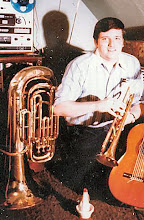




CD Listing
1. High Society
2. That's A Plenty
3. The World Is Waiting For The Sunrise
4. Up A Lazy River
5. Mahogany Hall Stomp
6. I'm Goin' Home
7. Margie
8. Farewell Blues
Liner Notes:
The Tradition reissue of this album includes new comprehensive liner notes.
Pete Fountain is the undisputed monarch of New Orleans jazz, and has been for decades. This album includes many gems from the early part of Fountain's career and showcases his ability as both band-leader and clarinetist. The jubilant energy of New Orleans comes through in every piece.
Pete Fountain came to national prominence as a clarinet player on The Lawrence Welk Show and is fond of telling the story of the time Mr. Welk asked him to go backstage and take over the bubble machine. He had never done it before and loaded the machine with too much juice. The result was bubble mayhem on stage.
This anecdote is a good little introduction to Pete Fountain, the man and the musician. You can hear this devilish prankster in every whimsical note of Dixie that flies through his clarinet on this album. But don't be fooled. Playing Dixie true to form is serious business.
Though some may see Dixie as simplistic and old fashioned, those who know better, and Pete Fountain does, will tell you that often the more simple it sounds, the harder it is to play. The more rigid the structure, the more difficult it is to project one's own voice. Pete Fountain does both and makes it sound natural and effortless.
There are many words that describe the music on this album: Melodic, energetic, sweet, fun, radical... Radical? Well, yes. This collection of Dixie standards was first released in 1959.
As many fans and historians know, 1959 was a benchmark year in the history of jazz. The year that saw the passing of Lester Young and Billie Holiday also gave birth to landmark albums by Charles Mingus, Duke Ellington, and Miles Davis. Davis' masterpiece, Kind of Blue firmly established modal jazz as a blueprint for much of the music's future - a style that dismissed the traditional chord structures of jazz's foundation. Modal music relied instead on players exploring melody and harmony in relation to an inverted musical idea or phrase.
Standing in sharp, if muted, contrast, was Pete Fountain. And, if in 1959 few saw the revival of Dixieland - the jazz style most firmly rooted in traditional chord structures - as a response to cool, this might serve as an interesting historical
footnote.
From when the very first note of Pete's clarinet hits after the two bar introduction in "High Society," you know everything is going to be alright. Such is the sweetness and surety of his tone that as he darts in and around the trumpet's melody, a feeling of well-being should immediately pervade the listening area. And then comes the solo! Here Fountain shows his true mastery, running up and down and around scales with incredible range and speed. Of course, it's easy to miss speed, hidden as it is within his silky smooth attack and technique. To top it off, he then takes out his bass clarinet and breezes through another couple choruses a few octaves down - a pretty good introduction to the Pete Fountain style and range.
After a strutted run through of "That's A Plenty," the album's second cut, "The World is Waiting for the Sunrise" finds Fountain in a slightly more contemplative mood as he makes his way almost mournfully through the theme. As the song progresses though, and the band begins to jump, the clarinet responds in kind. Here, it's fun to hear how Pete gets both melancholy and joy out of the same notes, as the clarinet gradually, but never completely, succumbs to the glee of the brass and rhythm section.
Following the introduction, the trumpet's working of "Up A Lazy River" includes some nice scale bending similar to the clarinets at the start of "Margie." The tempo here is decidedly slower than anything so far and the blues just drip off the notes.
As its name might suggest, "Mahogany Hall Stomp" marks a return to the upbeat. But, as if the bluesiness of the preceding tunes have had an effect, the tone here is more contemplative than the album's opening tunes. Which is not to say it isn't hot. The flame is just more blue than white. Trumpet leads off. followed by clarinet. The trumpet then returns in muted form and blows some impressive long notes.
"I'm Goin' Home is one of those songs which the adjective bittersweet was born to describe. While not exactly a traditional New Orleans second line, it does put one in mind of that final send off. But the sublime accented scales of the clarinet together with the occasional united trumpet punches, make it far more sweet than bitter - and serve as a strong argument against the playing of funeral dirges on such occasions.
As impressive as Pete is when he's noodling at high speeds. it's the slow. mellow, julep-sipping stuff that is most dramatic. "Margie" is an excellent example. On the opening phrase of the melody, Pete bends ablue note with exquisite force and subtlety). It's almost as if the turntable were suddenly spinning just a hit slower (And if l were listening to a vinyl copy. I might have checked). Then the love songs vocal is presented in that matter-of-fact. Hex. I don't really sing. but nobody else showed up for the gig. kind of was that works perfectly for this type of song. After the vocal, the trumpet piano and trombone run through the tune.
With "Farewell Blues" the album ends where it began. as Pete Fountain once again runs circles around everything without breaking a sweat. Too often, people dismiss Dixieland without really listening to it. Pete Fountain makes sure you pay intention. you'll be glad you did.



No comments:
Post a Comment